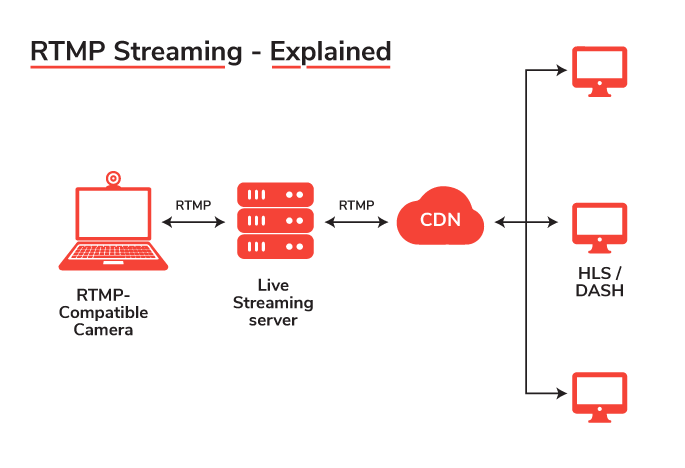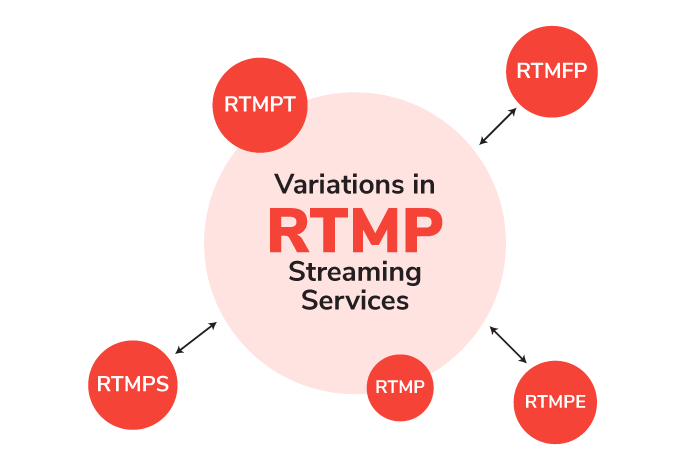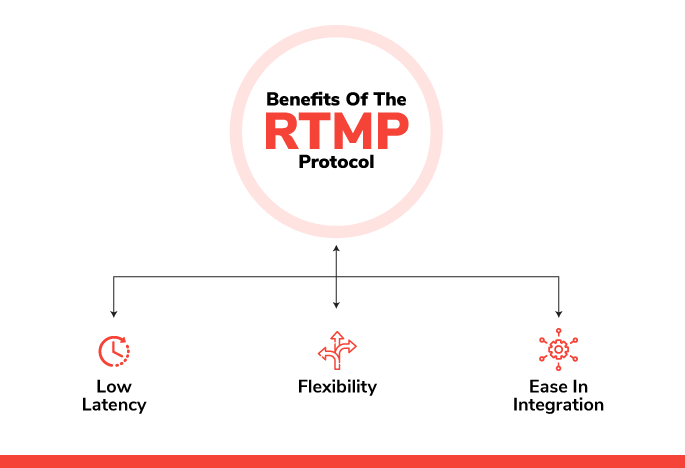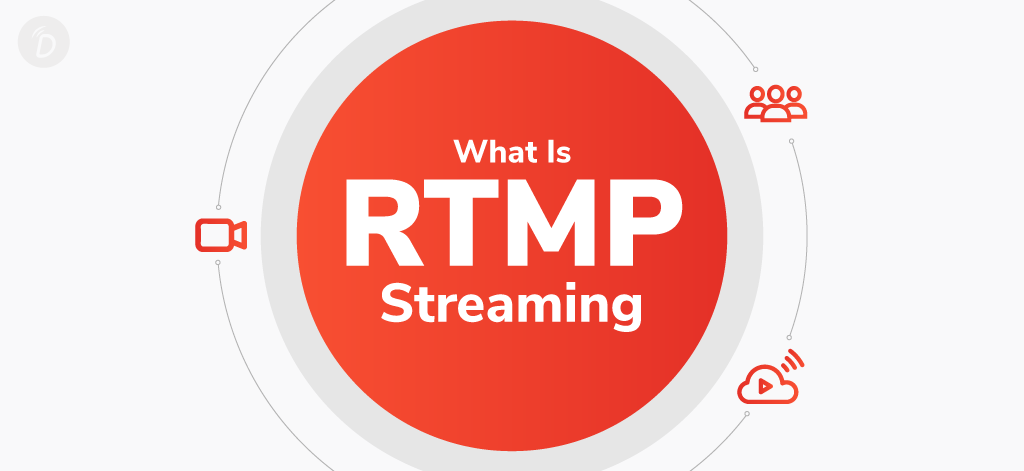With the increase in demand for online video streaming over the last few years, innovations are taking place to make it more accessible for the viewers to catch their favorite entertainment just with a single click !! One of the main components which had played a key role in delivering all the online content is -RTMP. It is because of RTMP streaming services, streaming has evolved constantly.
Let’s start with a quick note on RTMP. It stands for “Real Time Messaging Protocol” and is into use since 2002. It has evolved over the decades with the emergence of new technologies & thus shifted from the traditional prosumer tool to professional streaming technology.
RTMP Streaming – Everything you need to know in 2024
What is a streaming protocol?
It is defined as a standard method of the transmission of audio & video content between different devices over the internet.
This protocol sends “chunks” of (audio & visual content) from one device to another. For the overall process to happen, the end device must support the protocol which has been used by the sender.
What is RTMP Streaming -Explained
As explained earlier, RTMP stands for real-time messaging protocol and it tends to facilitate the transmission of audio, visual as well as data in real-time.
Basically, it is a TCP-based protocol which has been developed by Macromedia in the year 2002. Its primary function was to enable the smooth transmission of loading data, which was then required to play the adobe flash player. Now, with the emergence of new technologies, its functioning has evolved over the decades.
Now, RTMP is primarily used as an open source protocol for first-mile contribution and is also accepted by most of the service providers and encoders.

Terms Associated with RTMP Streaming
There are many terms that are directly related to this streaming protocol. However, we have explained some very popular ones below –
- ABS (Adaptive Bitrate Streaming) – as its name suggests, it is adaptive bitrate streaming which is mostly used for the compression & alteration of the video quality to match the available bandwidth.
It also ensures that the viewers see the video content in the highest quality matching the bandwidth. Somehow, due to any circumstances, if the bandwidth gets limited, it will automatically decrease the video quality to match.
- Latency- is defined as the time is taken viewer’s action and the web app’s response. When it comes to video live streaming, it refers to the delay in the transfer of data from the client end to the user side.
- (AMF) Action Message Format- it is a binary serialization format that has largely been used to exchange the data between adobe flash applications and the server. It allows the client to send messages to the server.
How does RTMP Streaming Work
An RTMP stream uses “packets” which chops the data into smaller fragments of audio & video. These packets are sent individually via different virtual channels defined by the streaming protocols, this is the basic efficiency of RTMP for live streaming.
Since, this technology uses a Transmission Control Protocol, it ultimately uses a three-way handshake while moving the data. This has been elaborated below –
- The first Handshake is when asking the server for starting a connection
- The second Handshake is when the server responds to the request
- The third Handshake is when the initiator is acknowledged
How to set up your own RTMP
There are five steps by which you can easily set up your RTMP live stream. Let’s have a quick look at them –
Step 1 Establishment of the connection to the Server
- The basic step involved is the connection to the server. You have to log in with your cloud server for windows. There you’ll find a “Remote Desktop Connection” link with the access data. Click the download button for the file to be downloaded.
Step 2 Installation of Ngnix Web Browser with RTMP module
- The software is a web server, but with certain addition of the modules, it thus enables streaming via RTMP. You can use the command prompt to start Ngnix. The server will run in the background.
Step 3 Configuration of RTMP
- For the preparation of the server for the RTMP, you need to modify the configuration file. You can use the text editor for the writing of the code.
Step 4 Release of the Port
- For allowing the users to access your stream, enabling a TCP port in the server firewall is a must. You can easily do this by logging into your cloud panel.
Step 5 The Final Step
- This is the final step of the streaming process. All you need is to download OBS software and simply enter your server in the streaming software.
Variations in RTMP Streaming Services
There are almost five major variations in the RTMP. All these video protocols tend to serve different purposes. These variations have been listed below –

RTMFP
It is defined as the real-time media flow protocol and is built on UDP instead of TCP. this tool lays the foundation for various video conferencing tools and social media apps. It requires less data which results in less cost of bandwidth.
RTMPT
It is the method of streaming the video through tunneling. Tunneling is the way to send your private data through public networks. It also introduces extra latency to the workflow.
RTMPE
It was basically an alternative secure streaming method that Macromedia had developed. Its usage is very limited now.
RTMPS
It uses an SSL certification to generate a more secure stream. It is still in use by some of the leading streaming platforms like – Youtube.
RTMP
RTMP proper is the oldest version of the protocol. This was also developed by Macromedia which has formed the foundation of other variations in the list as well.
What are the Benefits of the RTMP Protocol

With purely evolution-oriented streaming technology, RTMP has proved to be the pillar when it comes to online video streaming. Some of the salient features of the protocol have been described below –
- Low Latency :
Low latency thus helps to keep the video connection more stable especially in the case when the bandwidth gets limited.
Viewers of the widely live stream content like – webinars, etc. are the most benefited ones from the fast streams that don’t have a lot of lag.
- Flexibility :
RTMP is a very flexible protocol that allows its consumers to consume the content in whichever way they choose.
Instead of being forced to watch the content in the linear direction, RTMP feeds can be easily skipped, forwarded, or can be joined later on.
- Ease in Integration :
RTMP lets its users integrate different types of media types into a single source. In simple words, it is very easy to blend audio, video as well as text altogether.
Major Challenges Associated with RTMP Streaming
As RTMP is a practical protocol, there are some factors that have to be taken into consideration while streaming with RTMP. some of the common challenges have been described below –
- Compatibility with the HTTP :
It is a well-known fact that RTMP is not compatible with HTTP connections. As far as HTTP connection is concerned, it is a network channel that stays open to receive further HTTP requests rather than closing after the exchange.
- Support of HTML5 :
Nowadays, most of the modern stream methods are based on HTML5 players. RTMP is supported by most of the outdated flash players. Without the help of the HLS converters, RTMP cannot play on the HTML5 players.
- Lower Bandwidth :
RTMP streams are most frequently subjected to low bandwidths that cause most of the interruptions in the video feed. It is spoiling the user experience along with frustration and anger.
Alternatives for RTMP Streaming
As RTMP protocol has become incompatible with the innovation of new players like HTM5, there are some alternatives that can be a handy choice when it comes to online streaming of the video –
WebRTC
The only popular alternative to the RTMP is the WebRTC framework. It thus allows its users to connect directly with their respective browsers even with low latencies.
However, large-scale broadcasting used to be an obstacle when using WebRTC, but not in the case of real-time streaming.
SRT(Secure Reliable Transport)
SRT is defined as an open source technology that has been specifically designed for low latency streaming over some unpredictable public networks. It is a direct competitor with RTSP as well as RTMP. It is a first-mile solution adopted as encoders, decoders and players add support.
HLS
HLS comes with fast speeds, low latency, and acceptable features worldwide. If you are using an HLS protocol, your entire video will be compressed and transferred over to the HTTP. After this, HLS streaming will assemble all the sorted fragments into a single playlist so the viewers can watch the steady stream of content.
Most of the live streaming service providers like – Dreamcast, Youtube, Facebook, etc. use this protocol to the prevention of technical glitches during the ongoing streaming.
MPEG-DASH
It is also known as the brainchild of the industry expert when it comes to audio & visual standards. It is known by name as the moving pictures expert group.
It is an open-sourced protocol that is widely appreciated for being codec-agnostic. In simple words, it can use the content which has been coded under any format.
Miscellaneous
There are some miscellaneous topics that need to be covered for clearing understanding of the differences between protocols. Below are some of the common differences between any two
RTMP vs RTSP – Differences
- RTSP is defined as a real-time streaming protocol and is another protocol that is being used for video streaming purposes. It is not well known as compared to RTMP but has its importance in the field.
- The major difference between these two arises in the streaming process for which they are responsible. The job of RTMP is to transfer the video from the encoder whereas RTSP controls the command between the viewers and the video player.
RTMP vs HTTP Streaming – Differences
- RTMP streaming is enjoyed by most users for its low latency & minimal buffering features.
- On the other hand, HTTP is the most widely used streaming champ for its improved viewing experience with the addition of ABS technology. Its audio codes like – Apple Lossless etc. are of much more importance than RTMP.
Summing Up
RTMP plays a very important role when it comes to covering different aspects of live streaming. Only with the help of RTMP live streaming services, the live streaming industry has gone this far.
On briefing of the topic, let’s not consider the RTMP to be dead, rather it is still playing a crucial role from behind the scene rather than leading from the front.
Let’s not forget the greatest advantage of using RTMP is its universal use across leading social media platforms like- Facebook, Twitter, Youtube, etc.
FAQ
Is RTMP outdated?
No, not yet. But, for sure the priorities have been changed. Now, RTMP functions from behind, and the traditional way of streaming through RTMP had gone obsolete with time.
Should I use RTMP or HLS?
RTMP is the most widely used protocol which is required for ingesting HLS for playback. On the other hand, the delivery is segmented in the case of HLS.
What are Streaming Types?
Streaming basically refers to the different types of media content – it can be live or recorded and is delivered on all types of devices such as podcasts, webcasts, TV shows, etc.
Which protocol is used for video streaming?
RTP is widely used as a network protocol for the proper delivery of audio & video over the IP network. It is being used on an extensive scale in communication and entertainment systems which thus includes streaming media such as video conferences, television services, etc



















